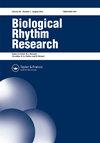公羊的代谢和行为日变化模式在夏季和冬季是否不同?
IF 0.9
4区 生物学
Q3 BIOLOGY
引用次数: 1
摘要
摘要本研究旨在比较10只Corriedale公羊在繁殖季节(BS)和非繁殖季节(NBS)睾酮、皮质醇、胰岛素、总血蛋白、白蛋白浓度、血糖、活动模式和表面温度的日变化模式。表面温度具有较大的介电常数,但幅度较低(P<0.001),并且其“顶相”在BS期间晚于NBS期间。BS期间皮质醇的介体和幅度低于NBS期间(两者均P=0.01)。睡眠时间的高峰期和血糖与胰岛素比率在BS期间比在NBS期间发生得更早(两者均P=0.001)。在BS期间,与NBS期间相比,睾酮的中间水平更高,血糖水平更高(P<0.001),胰岛素水平更高的趋势(P=0.06),但季节之间的每日变化模式没有变化。总之,尽管季节变化,但一些日变化模式是稳健的,并保持不变。其他模式,如表面温度、行为模式、皮质醇浓度和血糖:胰岛素比率,对环境变化或其引发的内部变化所产生的调节更敏感,可能是因为它们直接参与了公羊的季节适应。本文章由计算机程序翻译,如有差异,请以英文原文为准。
Does the metabolic and behavior daily variation pattern on rams differ in summer and winter?
ABSTRACT This study aimed to compare the daily variation pattern of testosterone, cortisol, insulin, total blood protein, albumin concentration, glycemia, activity pattern, and surface temperature in 10 Corriedale rams during the breeding (BS) and the non-breeding (NBS) seasons. The surface temperature had a greater mesor but a lower amplitude (P < 0.001), and its’ acrophase was later during the BS than during the NBS. The mesor and amplitude of cortisol were lower during the BS than during the NBS (P = 0.01 for both). The acrophase of the time sleeping and the glycemia:insulin ratio occurred earlier during the BS than during the NBS (P = 0.001 in both). During the BS, there was a greater mesor of testosterone, a greater glycemia (P < 0.001), and a tendency to greater insulin (P = 0.06) than during NBS, but without changes in their daily variation pattern between seasons. In conclusion, some daily variation patterns were robust and maintained despite seasonal variations. Other patterns such as the surface temperature, the behavior pattern, cortisol concentration, and glycemia:insulin ratio were more sensitive to the modulation exerted by environmental variations or the internal changes triggered by them, probably because they are directly involved in favoring the seasonal adaptation in rams.
求助全文
通过发布文献求助,成功后即可免费获取论文全文。
去求助
来源期刊

Biological Rhythm Research
生物-生理学
CiteScore
3.00
自引率
9.10%
发文量
34
审稿时长
6-12 weeks
期刊介绍:
The principal aim of Biological Rhythm Research is to cover any aspect of research into the broad topic of biological rhythms. The area covered can range from studies at the genetic or molecular level to those of behavioural or clinical topics. It can also include ultradian, circadian, infradian or annual rhythms. In this way, the Editorial Board tries to stimulate interdisciplinary rhythm research. Such an aim reflects not only the similarity of the methods used in different fields of chronobiology, but also the fact that many influences that exert controlling or masking effects are common. Amongst the controlling factors, attention is paid to the effects of climate change on living organisms. So, papers dealing with biometeorological aspects can also be submitted.
The Journal publishes original scientific research papers, review papers, short notes on research in progress, book reviews and summaries of activities, symposia and congresses of national and international organizations dealing with rhythmic phenomena.
 求助内容:
求助内容: 应助结果提醒方式:
应助结果提醒方式:


